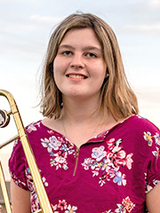From Sudden Cardiac Arrest to AED Advocate: Maddie’s Story
From Sudden Cardiac Arrest to AED Advocate: Maddie’s Story

High school senior Maddie wants all schools and sports teams to have CPR training and readily available access to an automatic external defibrillator (AED) — the very device that saved her life eight months ago.
On Sept. 14, 2020, Maddie was preparing for marching band practice on her high school field. With some time to spare, the 17-year-old trombone player decided to run a few laps around the track — a hobby she had recently picked up.
That’s the last thing Maddie remembers before waking up from a coma in Children’s Hospital of Philadelphia (CHOP) over four days later, when she learned she had suffered a sudden cardiac arrest (SCA) and collapsed.
Fortunately, there were people nearby, and they launched into action. Staff members called 9-1-1, immediately began CPR and used an AED to restore Maddie’s heart rhythm.
“They didn’t give up on me,” says Maddie. “They’re the reason I’m still here.”
Maddie was taken by ambulance to a local hospital and medivacked to CHOP shortly afterwards. The details of the three weeks spent in the hospital are blurry, though Maddie remembers snippets of occupational therapy sessions, many x-rays and scans as well as surgical preparation.
Having determined Maddie’s cardiac event to be idiopathic (meaning having no known cause), CHOP doctors placed a battery-powered device known as an implantable cardioverter defibrillator (ICD) just under Maddie’s skin. In the event Maddie experiences an abnormal heart rhythm in the future, the ICD will deliver an electric shock to restore a normal heartbeat and prevent cardiac arrest.
Although it at first scared Maddie that she could not remember the details of the ordeal she’d experienced, her fear quickly found a powerful outlet: advocacy.
More AEDs, more lives saved
Maddie knew her life had been saved by the quick actions of her high school staff. She also knew that without access to an AED, her story could’ve ended tragically. Each year, SCA claims the lives of more than 2,000 children and adolescents in the United States and is the leading cause of death in young athletes, deaths that could be prevented with increased availability of AEDs. Maddie decided she was going to do something about that.
“I’ve always been into helping others,” says Maddie, who’s no stranger to fundraising. “Making sure other kids would be okay was my way of helping myself.”
While still recovering in the hospital, Maddie began to fundraise for CHOP’s Youth Heart Watch, a program that aims to prevent sudden cardiac death among children by placing AEDs in schools, recreation centers and other public places.
Maddie’s initial goal was to raise $5,000 to support the purchase of AEDs; at the time of this writing, she has nearly doubled her goal, raising almost $10,000, enough to purchase more than six AEDs for schools. Grateful for the amazing clinicians who supported her at CHOP, Maddie also launched a toy drive for children in the Cardiac Center, raising $4,000 for toys and activities to keep children entertained while undergoing treatment in the hospital.
Making Bucks County “heart safe”

Since returning home from CHOP, Maddie has become even more determined to use her experience for good. She has spoken at local rotary clubs — inspiring business owners to become trained in CPR and to purchase AEDs for their offices — and to Bucks County superintendents about the importance of AEDs and CPR training in their schools.
Designation as a “Heart Safe School” recognizes a school’s efforts to prevent sudden cardiac death through education, training, preparedness and availability of AEDs. Maddie’s ultimate goal is for all Bucks County schools to achieve this potentially life-saving designation.
“I’m living for a lot of people that didn’t survive,” says Maddie. “Their families deserve to know that things are changing. Doing my part in Bucks County really does make me feel good.”
Headed to Widener University in the fall, Maddie looks forward to joining the marching band and plans to pursue a career in nursing. Given her continued dedication to kids’ heart health and safety, her desired focus is perhaps unsurprising: pediatric cardiology.